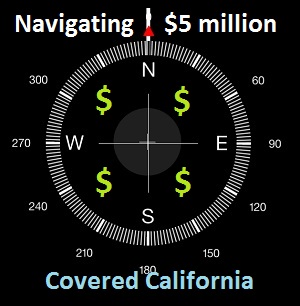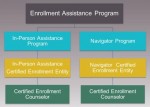As if Covered California doesn’t have enough to do with fixing website problems, enrolling Certified Enrollment Counselors and certifying insurance agents to sell their health plans, they now have to launch a $5 million grant program to create regional Navigators. It is unfortunate that the rules associated with the Affordable Care Act mandate that states that set up their own exchanges must also create a Navigator program that looks virtually identical to the fledgling Certified Enrollment Entities and Counselors In-Person Assistance Program.
A recent webinar by Covered California on the design of the Navigator program provided the following slides from the power point presentation.
$5 million on an unproven Navigator program
Covered California is in the initial stages of designing the Navigator program to be funded by $5 million in grants. Navigators will essentially be like Certified Enrollment Entities but instead of receiving $58 for each successful application, the Navigators will just be given a pot of money to go out and enroll people. With the $5 million dollars, Covered California hopes the Navigators will enroll 110,350 people during the 2015 open enrollment period (October 15th – December 7th).
$45 is no incentive
With a little simple math, $5 million divided by 110,350 equates to $45.31 per enrollment. That is less than the $58 Certified Enrollment Counselors are paid but hardly an incentive for what Covered California hopes will be “a clear organizational readiness to engage in aggressive sales-driven education and enrollment activities.” A lump sum grant does not create an aggressive sales-driven organization. A lump sum grant invites organizations to smile, be polite, shuffle paper and make excuses why they didn’t make their numbers.
Does the current In-Person Program even work?
The current Certified Enrollment Entity/Certified Enrollment Counselor In-Person Assistance program at least has some monetary incentive to generate enrollment. Covered California expects the Navigators to also have an army of Certified Enrollment Counselors but it is unclear how those people will actually be paid. They are also hoping the new Navigators will organize grand outreach events from the grant money.
Covered California shouldn’t be designing any new programs until they find out if their existing In-Person Assistant Program even works!
What is the cost of current programs and are they effective?
The sample budget that Covered California provides for Navigators doesn’t have funding to pay the Certified Enrollment Counselors. By the third week of October, Covered California only had 390 enrollment counselors with another 4,165 waited to be certified. There were 272 Enrollment Entities with an additional 237 waiting their paperwork. In short, Covered California doesn’t even know if their In-Person Assistant Program is working and they are already gearing up to spend another $5 million on an unproven program.
Another program to spend money
What about the $3 million in grants to the various organizations for outreach and education? Has that money been effective in driving Californians to sign up for health insurance? Isn’t the combination of the outreach and education grants with the Certified Enrollment Counselors that same thing as a Navigator program?
How many CEC’s will defect to be Navigators for easy grant money?
It was mentioned during the webinar that a Certified Enrollment Entity could not have a dual role as also a Navigator. A current CEC would have to give up the compensation of the program if they took the grant money to be a Navigator. I heard nothing mentioned that the recipients of the outreach and education grants can’t apply and take the money for the Navigator program.
Real sales are not driven by fluffy grant money
If the current marketing and sales efforts of the outreach grants, Certified Enrollment Entities, Counselors and over 2,000 insurance agents can’t reach the enrollment numbers that Covered California hopes for, I doubt that throwing another $5 million at additional efforts one year down the road will make much difference. This is one instance where California should return the $5 million dollars back to the Feds and chart our own course for success.





